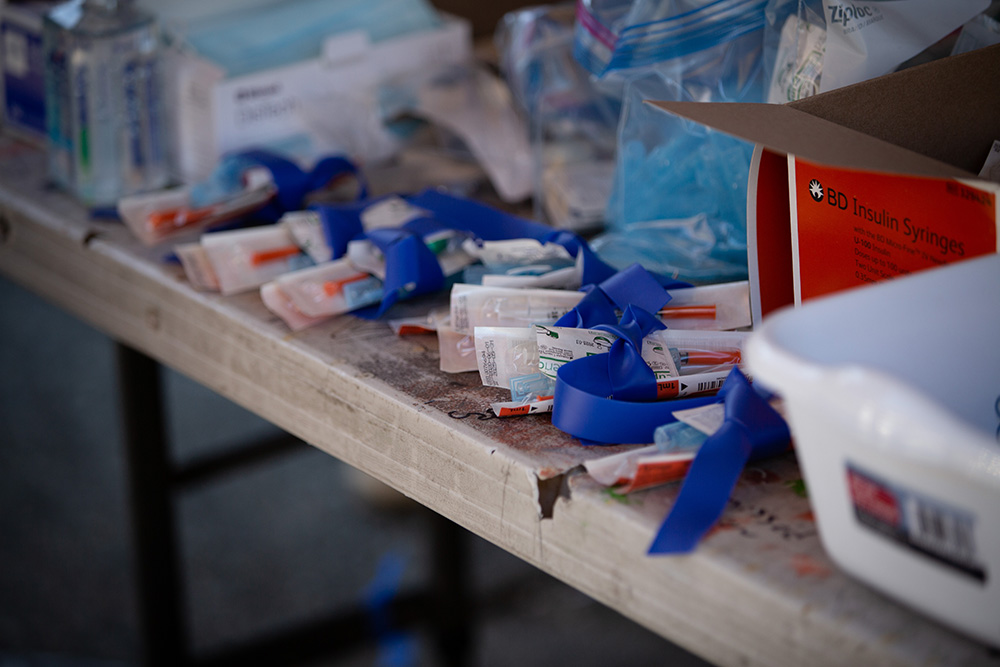British Columbia will spend $500 million across several ministries to bolster its overdose emergency response and increase mental health and substance use services in the next three years amid mounting toxic drug deaths.
The commitment in today’s budget comes after the province’s deadliest year for drug poisoning, with 1,768 people dead.
“We are taking action to help end the tragedy playing out in communities around British Columbia,” said Finance Minister Selina Robinson as she tabled the budget in the legislature. “Our plan meets the unprecedented need with a historic response.”
But the commitment falls far short of the $2 billion over five years the Canadian Mental Health Association has said is needed to build a comprehensive mental health-care system, something the government called non-existent before it took power in 2017.
“This is absolutely a step in the right direction, spending wise,” said Jonathan Morris, CEO of the CMHA’s B.C. division. “But this can’t be a flash in the pan. We will need to see this kind of sustained response.”
Nearly 200 new treatment beds will be publicly funded with $133 million in the next three years. An additional $152 million will be spent on ongoing opioid use disorder treatment initiatives, and $45 million will go to new harm reduction services like supervised consumption sites announced last week.
“Through Budget 2021, we are accelerating and expanding programs put in place to respond to the overdose crisis,” Robinson said. “Many of the emergency measures brought in during the pandemic to help keep people alive are now permanent.”
Drug user advocates have said the budget, which prioritizes prevention and treatment, needs to focus on much-needed safe supply efforts to keep people alive while a system of care is developed.
“We hope it’s not just pilot projects anymore around safe supply, we need a sustained safe supply program still,” said Leslie McBain, co-founder of Moms Stop the Harm. “It always comes down to stopping the deaths.”
McBain also hopes expanded treatment and recovery services are equitable, accessible and include some with more evidence-based standards, including for people who don’t want to pursue abstinence-based programs. “People go into treatment and hopefully they make it through, but will the support be sustained? Because it will take more than a year or two or three of services for them to recover.”
When The Tyee asked about funding commitments for the long-awaited safe supply directive, Robinson defended the province’s approach and focus on longer-term goals like treatment and recovery. “There are services that are expanding because we know what works and works so well,” she said.
BC Green Party Leader Sonia Furstenau said Tuesday she was “very disappointed not to see a mention of really leaning into a regulated safe supply that would save lives.”
Preventative care for children and youth is also a focus of the new funding, which earmarks $97 million for mental health programming in schools and previously announced additional Foundry youth clinics.
The First Nations Health Authority will also receive $14 million to deliver culturally safe services to Indigenous people in B.C., who are more than five times as likely to die of poisoned drugs than non-Indigenous people.
And long criticized as under-resourced and blamed for the province’s failure to curb toxic drug deaths, the Ministry of Mental Health and Addictions budget will grow from $10 million to $13 million annually. The increase will fund the Provincial Support Office to co-ordinate quadrupling of integrated mental health teams for kids and youth from ages five to 20 across B.C.*
“Building out a system and focusing on youth is the priority of A Pathway to Hope,” Robinson said of the province’s 2019 mental health and substance use strategy.
Medical Services Plan coverage of psychology services, a pilot project for which the Greens advocated, was notably absent from the budget. “I’m disappointed because that was such an opportunity to improve care,” said Furstenau.
Morris would also have liked to see financial commitments to reduce wait times for specialized care and psychiatry, which can exceed a year in B.C.
Health spending broadly will grow by $2.6 billion over the next three years to hire more than 3,000 health-care workers and aides for long-term care, decrease diagnostic and surgical wait times and expand primary care centres, all cornerstones of the NDP’s fall re-election campaign.
Free contraception under MSP, another campaign promise, was also not in the budget.
The province has committed $59 million over three years to hiring Indigenous liaison workers in every health authority and implementing the recommendations of the recent report into anti-Indigenous racism in health care.
Budget allocations for seniors care, where failures have been highlighted by the pandemic, focus on $68 million to bolster home care and $12 million to support home health monitoring for people with complex needs.
Seniors Advocate Isobel Mackenzie said the investment in home care is heartening but co-payments for clients need to be eliminated to make it truly accessible for all. “I don’t think the change is recognizing the degree to which we need to improve home support services for people to be able to remain at home,” she said in an interview.
Capital spending includes 20 projects to add about 1,500 new long-term care beds and refurbish 2,800 existing beds, Robinson said.
It’s reasonable to focus on long-term care after the pandemic put it in the spotlight, Mackenzie said, but it shouldn’t be the focus in taking care of seniors. “When we look at who is going to long-term care and why, we’re still finding people who could live in the community successfully with better funded support and help,” said Mackenzie.
Mackenzie and other advocates have called for greater public funding for long-term care facilities and better regulation and accountability to government as the virus ripped through seniors in care.
Mackenzie said more funding would allow increased staff to provide care. She also wants to see better staff training, education and compensation.
Mike Old, interim secretary-business manager for the Hospital Employees’ Union, called for construction of more public and non-profit care homes.
“In the coming years, we require an ambitious capital plan to build public and non-profit care homes, while holding for-profit care home operators to account for the public money they receive to provide care,” he said in a statement.
When asked what the province was doing to address structural issues, Robinson said $258 million over three years to ensure staff only work at one site helps reduce infection risk.
*Story updated on April 21 at 1:46 p.m. to clarify how the increase in funding to the Ministry of Mental Health and Addictions will be allocated. ![]()
Read more: Health, BC Politics

















Tyee Commenting Guidelines
Comments that violate guidelines risk being deleted, and violations may result in a temporary or permanent user ban. Maintain the spirit of good conversation to stay in the discussion.
*Please note The Tyee is not a forum for spreading misinformation about COVID-19, denying its existence or minimizing its risk to public health.
Do:
Do not: